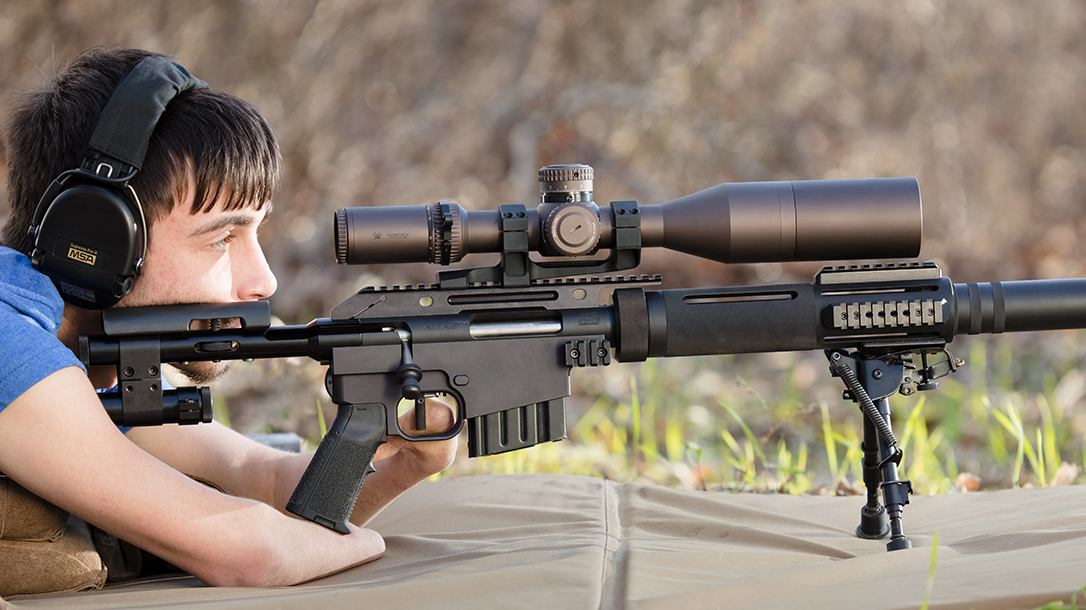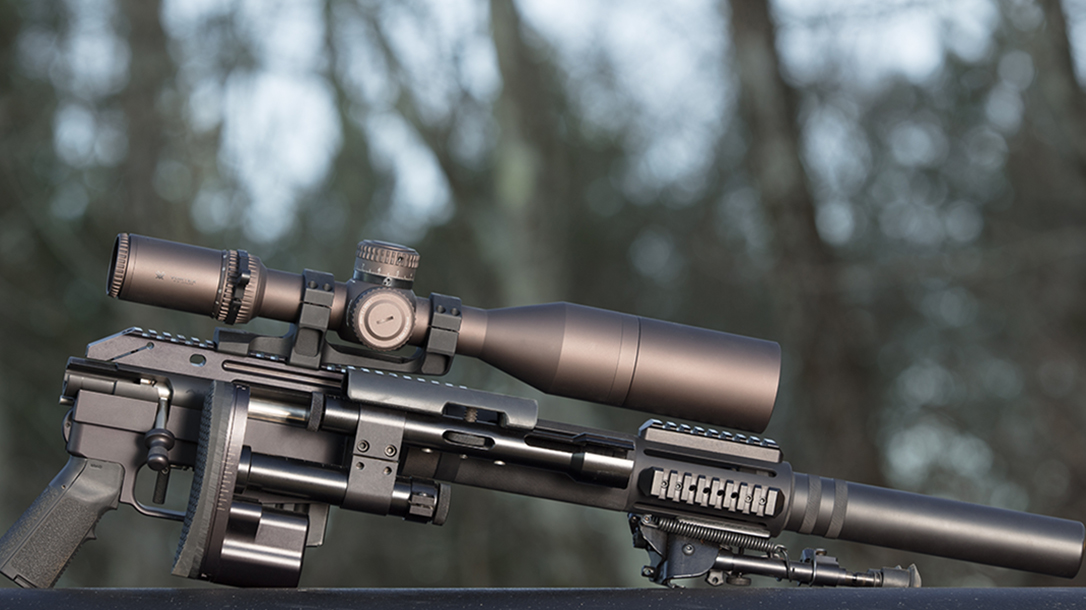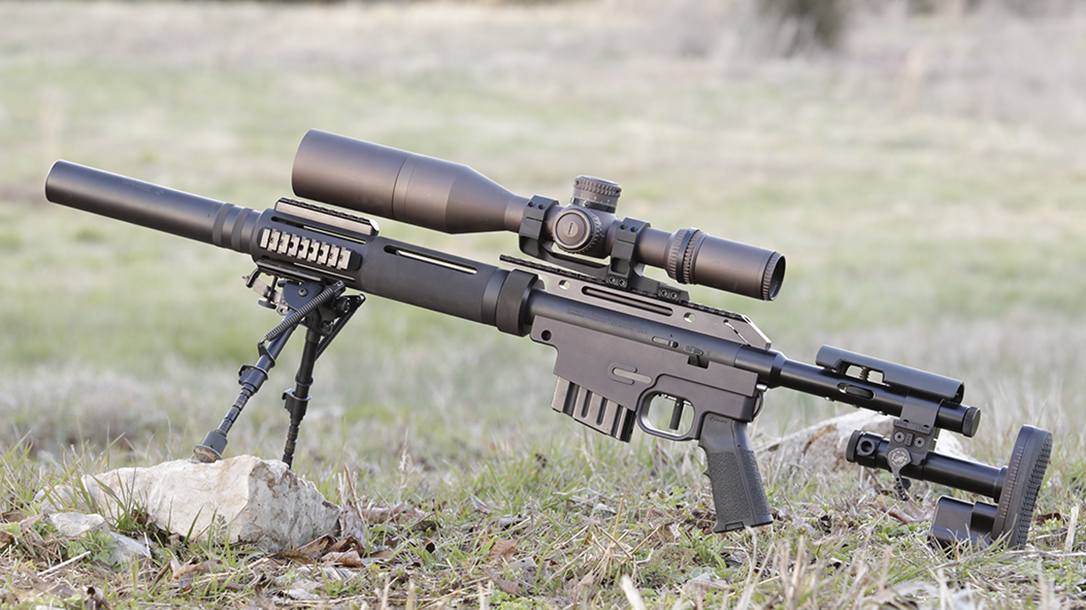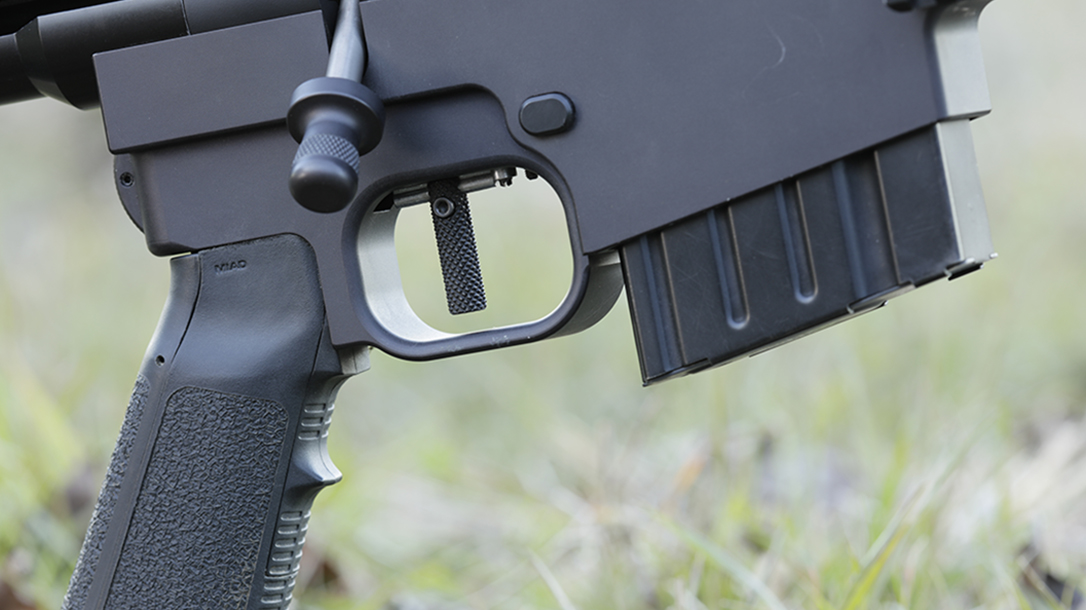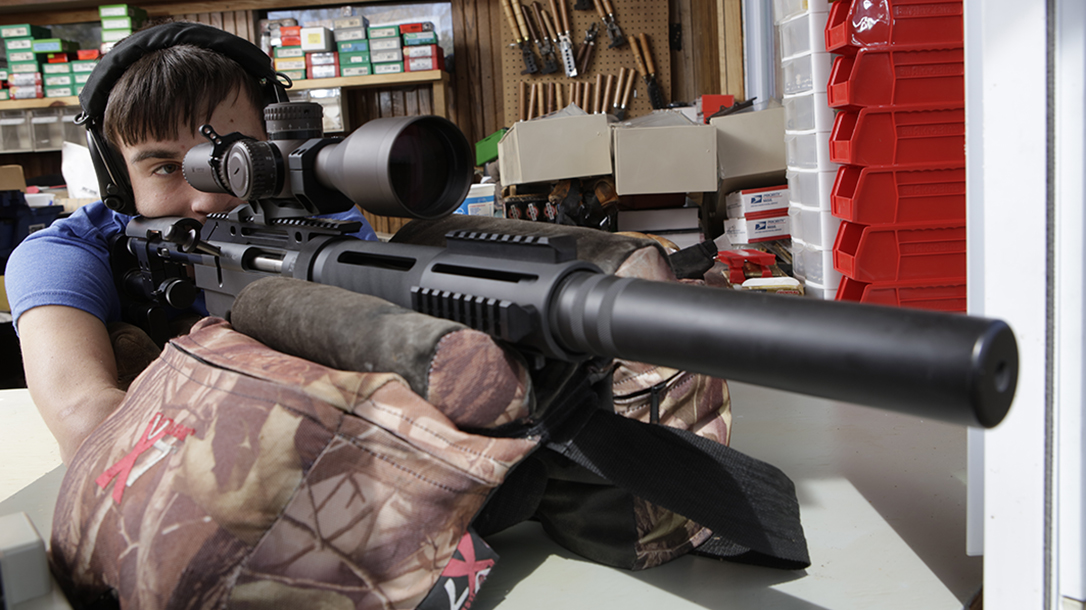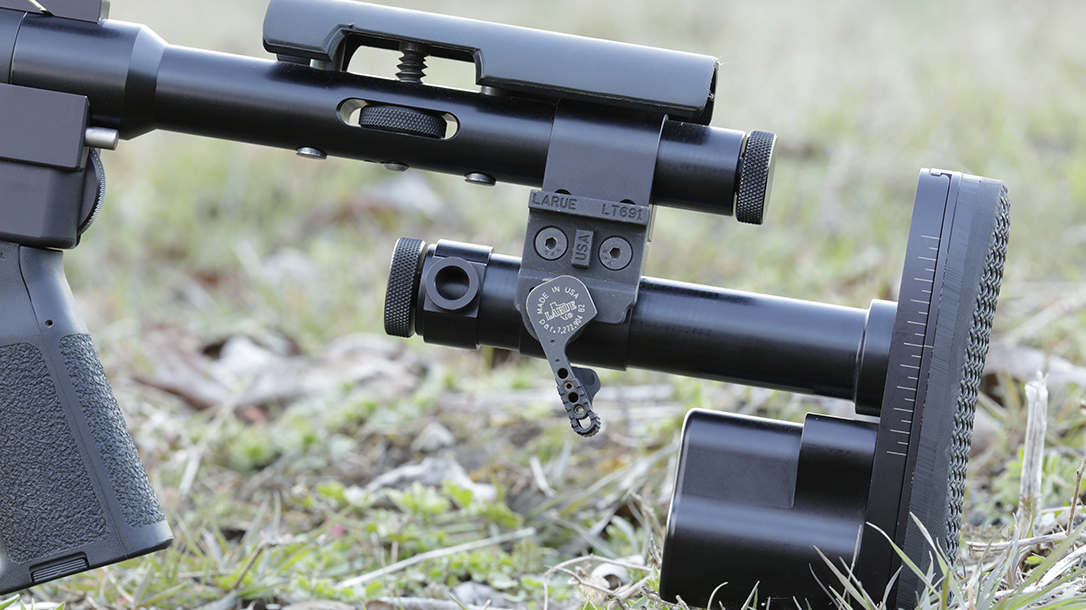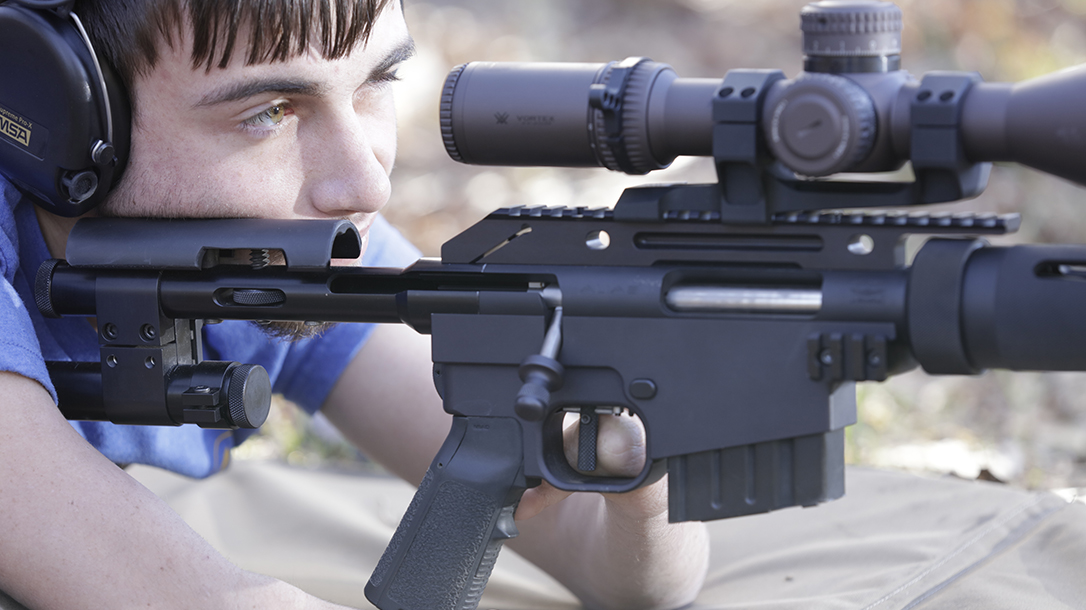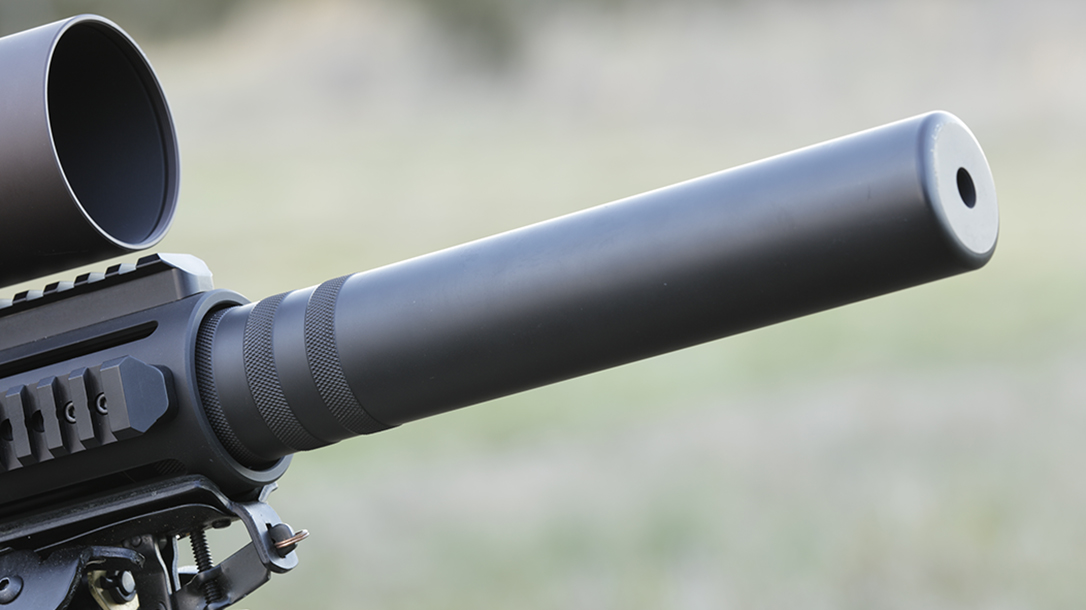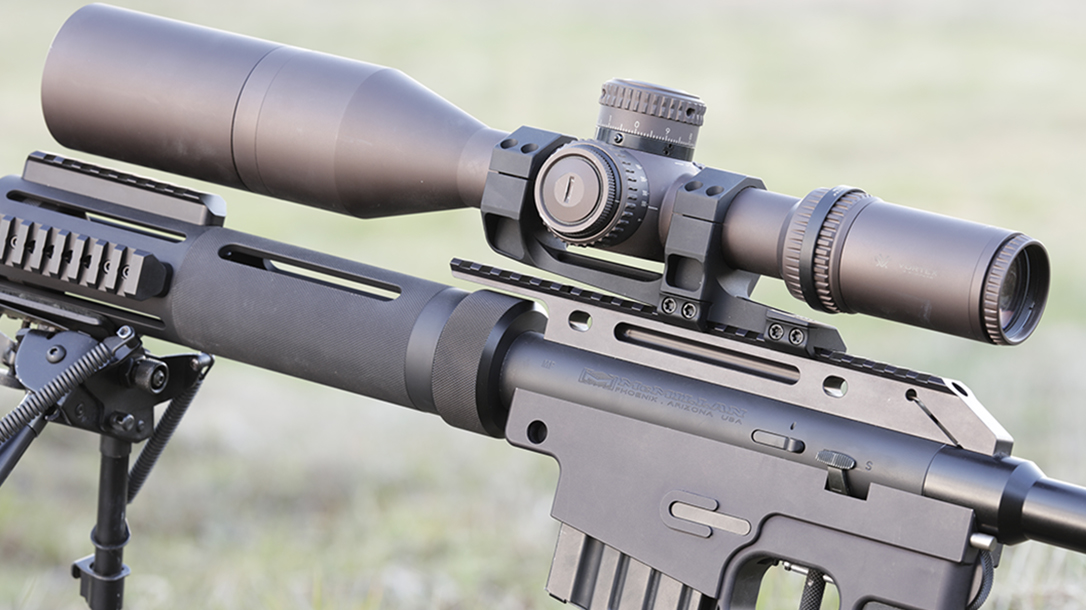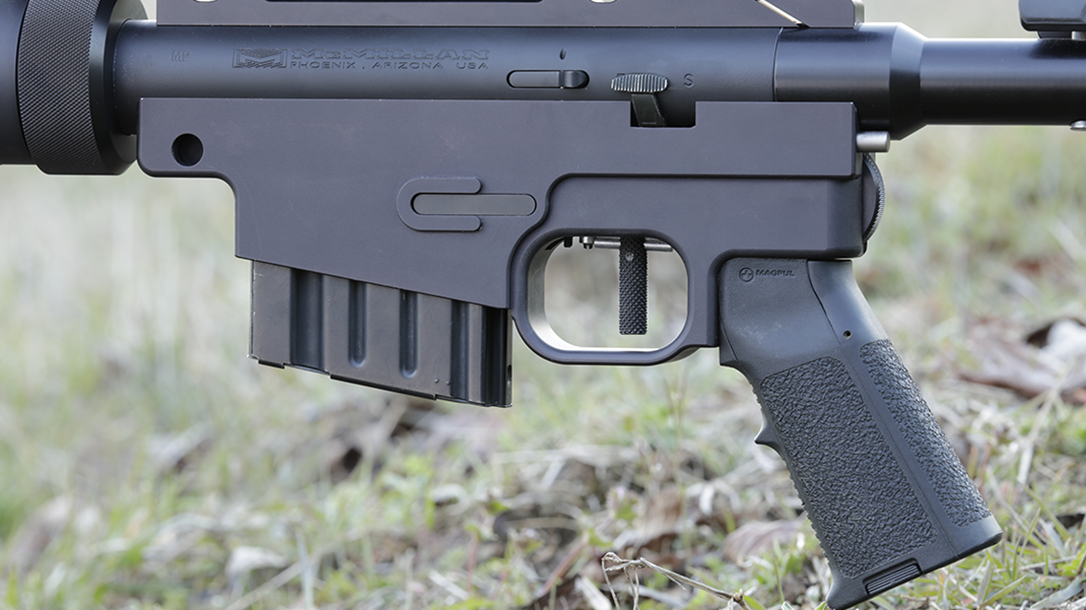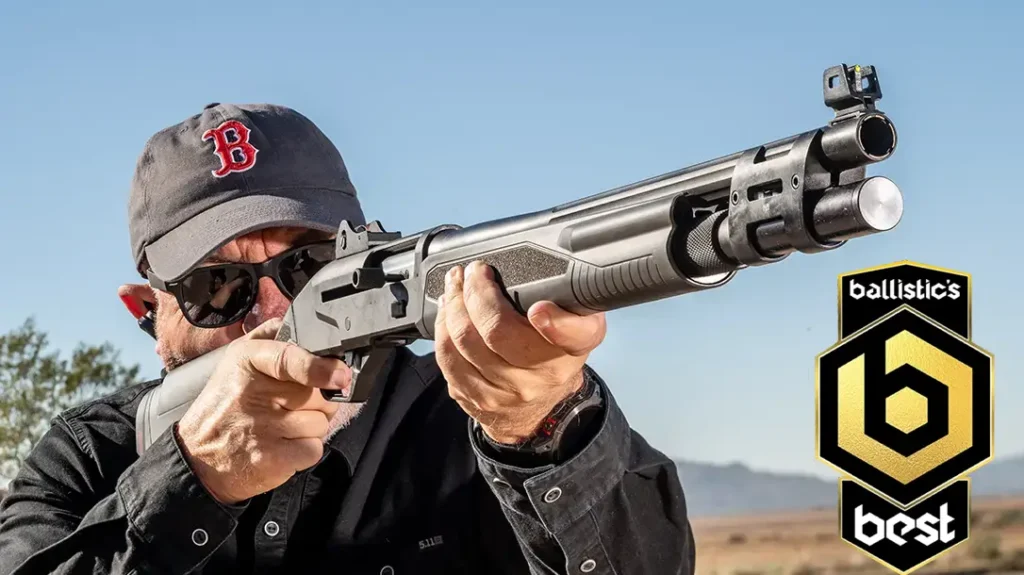Hunter “Nubs” Cayll always seems to be in a hurry. Born 2.5 months early, the 22-year-old professional 3-Gun shooter came into the world with no hands. But watching him work, it’s hardly a disability, and Cayll’s “hands off” approach to the world is amazing. Cayll is employed by Strategic Armory Corps (SAC), which owns several companies in the gun industry, including McMillan Firearms. And when it came time to review McMillan’s new ALIAS CS5-T, a short-barreled rifle (SBR) that’s considered an NFA Class III weapon, I crossed paths with Cayll. He brought a company sample to my farm for a day of shooting.
The Shooter
Cayll has a lot in common with my own 20-year-old son, Luke. They’re both avid “Call of Duty” players, but Cayll, by contrast, took his passion to the professional level. My son should go pro given the amount of time he spends with a video game controller in his hands.
Advertisement — Continue Reading Below
I suspect that Cayll’s transition from electronic shooting to 3-Gun competition was influenced by the former, and I’m certain that “shoot ’em up” games sparked my son’s interest in everything weapons. Cayll’s transition from big-money professional gaming to competitive shooting came three years ago.
Sitting in my kitchen after a long day of shooting, my wife and Cayll talked about several different things. And his response to one of her questions spoke volumes about the young man. It was during the height of the NCAA college basketball tournament, and she asked him which team was his favorite to eventually make it to the Final Four.
“I don’t really have one,” Cayll said. “I don’t watch sports on TV. I’m not much of a watcher. If I can’t do it, it won’t hold my interest.”
Advertisement — Continue Reading Below
It’s hard to imagine, but Cayll has also squeezed mixed martial arts fighting into his busy schedule. “I did surprisingly well in MMA,” he said. “When I get these nubs locked around somebody, it’s just about impossible to pry them apart.”
Growing up and living in Lawrenceburg, Tennessee, a part of the Volunteer State that’s equine country, it made sense for the energetic youth to train and competitively show Tennessee walking horses. “Pretty much, if somebody told me I couldn’t do something, I went out and did it,” he said.
The Rifle
McMillan designed the bolt-action ALIAS CS5-T for stealth law enforcement countersniping in urban settings. Designed as a compact and concealable precision rifle, it’s sold in a suppressed configuration for military and law enforcement applications but can be purchased by civilians in accordance with NFA rules. The “T” in CS5-T stands for the tubular handguard. The CS5-Q comes with a vented quad-rail handguard.
Advertisement — Continue Reading Below
Rock McMillan developed the ALIAS action after receiving input from world-class competitive shooters. From an engineer’s perspective, the ALIAS design solves several weak points found in conventional bolt-action rifles, taking the platform to new heights. Without a stock or chassis, you don’t have to bed the action. This translates to less vibration or flex, which means you have more accuracy on tap. And weather won’t really affect the gun’s capabilities.
The receiver is machined from 17-4 stainless steel. The design also incorporates a solid top with a small loading/ejection port for greater strength. The loading port itself is angled to make it easier to load single rounds.
A Closer Look
One of the goals in designing the ALIAS bolt action was slick operation. To that end, the action uses a pair of cams that reduce the amount of force required to lift the bolt handle. The handle—shaped like a fat-brimmed top hat—has a 75-degree throw for even more speed, and the handle will clear large-belled 35mm tactical riflescopes with ease. In the field, I found it easy to run the bolt with just one finger.
Advertisement — Continue Reading Below
The bolt itself is machined from 9310 carbon steel that has been hardened to specific parameters. The bolt face is also cone shaped in comparison to most bolts, which have flat faces. This aids in reliable feeding, particularly when using cartridges with sharp shoulders.
On the backstroke, the bolt slides back into the buttstock’s receiver extension, which also has a small cheekpiece. Compared to a traditional bolt action, the barrel and bolt are much lower, creating an in-line recoil path. This means a shooter can stay locked in position while firing and running the bolt. Even under recoil, it’s easier to stay in the scope and watch the bullet trace.
The match-grade stainless steel barrel on the CS5-T is 12.5 inches long. It has a fast 1-in-8-inch twist rate to help stabilize long subsonic bullets. The muzzle is also threaded and comes fitted with a muzzle brake/adapter for sound suppressors. McMillan normally ships the rifle with an AWC PSR suppressor, but our test sample used a model from EliteIron. Without a suppressor mounted, the gun weighs 10.6 pounds unloaded.
Advertisement — Continue Reading Below
Fully Adjustable
The highly adjustable buttstock will fit any operator, regardless of build, gear or shooting position. First, the length of pull can be adjusted by 4 inches. Shooters can also adjust the buttstock for cast or offset by loosening four screws, and the buttplate can be rotated 360 degrees. It’s also adjustable for height by 1.5 inches. The cheekpiece can be lifted vertically by about an inch.
With the buttstock and suppressor detached, the CS5-T is less than 24 inches long, making it easy to hide in a backpack or other inconspicuous carriers. The stock release can be found just above the pistol grip at the rear of the receiver. Slide the latch down toward the grip and pull the buttstock assembly rearward to remove it.
The safety indicator is on the left side of the receiver at the junction of the bolt tube and what would be the lower receiver on an AR. Coincidentally, an AR-style pistol grip is used on the CS5-T, and our test sample came with a Magpul MIAD grip installed.
Advertisement — Continue Reading Below
Magazines & Trigger
The rifle is designed to use Armalite AR-10-style magazines for convenience, and the magazine release is just above and forward of the triggerguard. It’s easy to manipulate with the right trigger finger. The safety is on the left side of the receiver, and it snaps into its “safe” and “fire” positions so shooters can sense what condition the weapon is in. It’s also worth noting that the rifle can be disassembled with the safety on or off.
Finally, we come to the CS5-T’s match-grade Anschutz trigger, a highly adjustable two-stage affair. The trigger on our test rifle was set for a 1-pound first stage and a 0.75-pound second stage to break the shot. Even the position of the trigger can be tailored to fit your hands better—or lack of hands in Cayll’s case.
Rounds Downrange
According to McMillan, the ALIAS CS5-T will deliver 0.5-MOA accuracy or better with match-grade sub- or supersonic .308 Winchester ammunition. To prove its capabilities, Cayll and I were able to test it with five supersonic loads and one subsonic load.
Advertisement — Continue Reading Below
We used an Oehler Model 35P chronograph set 15 feet from the muzzle to gather velocity figures with each load. To measure the rifle’s accuracy initially, we mounted a 4.5-27x56mm Vortex Razor HD Gen II scope on the CS5-T and fired it from a concrete-reinforced bench with a target set out at 100 yards. Cayll and I alternated, taking turns on the gun during all of the tests.
Nexus Ammo, another SWC company, provided two loads for testing. The first was a 175-grain Match BTHP load that had an average velocity of 2,404 fps and a standard deviation of 19. The smallest group with this load measured 0.69 inches. Nexus also provide a 175-grain subsonic load that had an average velocity of 1,040 fps and created a 100-yard group measuring 1.22 inches.
Advertisement — Continue Reading Below
Next up was Black Hills’ 168-grain Match ammo, which created a best group measuring 1.04 inches wide. Here the average velocity was 2,319 fps with a standard deviation of 15. Federal’s 168-grain Gold Medal Match load averaged 2,338 fps with a standard deviation of 13, and it created a 0.55-inch group, the smallest of the day.
Remington’s 168-grain Premier Match ammo averaged 2,237 fps, with a standard deviation of 24. Its smallest group was 1.31 inches wide. The last load was Hornady’s 155-grain Match A-MAX, which averaged 2,497 fps. This load produced a standard deviation of 13, and its smallest group was 1.05 inches wide.
Further Testing
Switching to my 1,000-yard range proved challenging that day. Winds were a stout 16 mph, with gusts to 25. The winds were also variable in direction between the firing line and the 1,000-yard target. Hits on steel that day were a piece of cake out to 400 yards, but it got tricky from there. At 500 yards, hits were harder to achieve, and hits beyond 700 yards were all but impossible because of my range’s configuration. You have to shoot through a narrow corridor of tall trees. At that range, the bullet was about 35 feet above the line of sight, and the wind carried the bullet into the tops of the trees, deflecting them.
Ready To Strike
McMillan’s ALIAS rifles are designed for the ultimate in customization, and the ultra-compact suppressed CS5-T gets the nod for discreet carry and concealment. It’s a small package that will put rounds on target consistently and with authority.
McMillan Alias CS5-T Specs
| Caliber: .308 Winchester |
| Barrel: 12.5 inches |
| OA Length: 23.5-38 inches |
| Weight: 12.25 pounds (empty) |
| Stock:Adjustable, skeletonized |
| Sights: None |
| Action: Bolt |
| Finish: Matte black |
| Capacity: 10+1 |
| MSRP: N/A |
McMillan Alias CS5-T Performance
| Load | Velocity | Accuracy |
|---|---|---|
| Black Hills 168 Match | 2,319 | 1.04 |
| Federal 168 Gold Medal Match | 2,899 | 0.55 |
| Hornady 155 Match A-MAX | 2,502 | 1.05 |
| Nexus 175 Match BTHP | 2,404 | 0.69 |
| Nexus 175 Subsonic BTHP | 1,040 | 1.22 |
| Remington 168 Premier Match | 2,237 | 1.31 |
*Bullet weight measured in grains, velocity in fps by chronograph and accuracy in inches for best five-shot groups at 100 yards.
For more information, visit mcmillanfirearms.com.
This article is from the May/June 2018 issue of “Tactical Life” magazine. To order a copy and subscribe, visit outdoorgroupstore.com.
